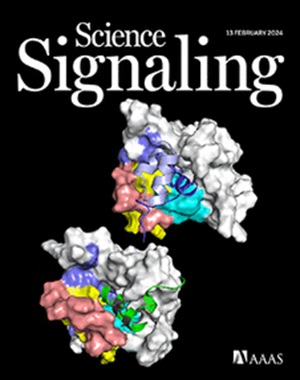Mitochondria Signal to Nucleus Through PKD
IF 6.6
1区 生物学
Q1 BIOCHEMISTRY & MOLECULAR BIOLOGY
引用次数: 0
Abstract
When cells are stressed by stimuli that lead to the production of reactive oxygen species (ROS) by the mitochondria, the abundance of mitochondrial manganese-dependent superoxide dismutase (MnSOD) is increased. However, a nuclear SOD2 gene encodes this mitochondrial enzyme; thus, the mitochondria must signal to the nucleus to trigger the expression of the SOD2 gene. Storz et al. show that protein kinase D (PKD), Src, Abl, and protein kinase Cγ (PKCγ) partially translocate to the mitochondria when cells are exposed to hydrogen peroxide or to agents that inhibit the mitochondrial respiratory chain [rotenone or diphenyleneiodonium chloride (DPI), which increase mitochondrial ROS production. Furthermore, PKD phosphorylation and activity was stimulated by these conditions that produce oxidative stress. RNA interference (RNAi) to decrease PKD abundance blocked the increase in expression of SOD2 (measured by an SOD2 reporter construct) in response to mitochondrial oxidative stress. The SOD2 gene is regulated by the Forkhead transcription factor FOXO3a and by the transcription factor NF-κB. Mutation of the FOXO3a regulatory site did not inhibit SOD2 induction in response to peroxide or mitochondrial oxidative stress. However, expression of a superdominant version of the inhibitor of κBα (IκBα) blocked the increase in MnSOD abundance in response to either mitochondrial oxidative stress or activated version of Src or PKD. When PKD was depleted with RNAi, the induction of an NF-κB reporter in response to peroxide or mitochondrial oxidative stress was blocked. This pathway from the mitochondria to the nucleus through PKD was important for cell survival during periods of ROS induction. Cells in which PKD or MnSOD was depleted with RNAi showed a higher frequency of cell death in response to doses of peroxide or DPI that did not cause cell death of control cells.
P. Storz, H. Döppler, A. Toker, Protein kinase D mediates mitochondrion-to-nucleus signaling and detoxification from mitochondrial reactive oxygen species. Mol. Cell. Biol. 25, 8520-8530 (2005). [Abstract] [Full Text]
线粒体通过 PKD 向细胞核发出信号
当细胞受到刺激而导致线粒体产生活性氧(ROS)时,线粒体锰依赖性超氧化物歧化酶(MnSOD)的含量就会增加。然而,核 SOD2 基因编码这种线粒体酶;因此,线粒体必须向细胞核发出信号,以触发 SOD2 基因的表达。Storz 等人的研究表明,当细胞暴露于过氧化氢或抑制线粒体呼吸链的药物[鱼藤酮或二苯基氯化碘(DPI),它们会增加线粒体 ROS 的产生]时,蛋白激酶 D(PKD)、Src、Abl 和蛋白激酶 Cγ (PKCγ)会部分转位到线粒体。此外,PKD 的磷酸化和活性也会受到这些产生氧化应激的条件的刺激。降低 PKD 丰度的 RNA 干扰(RNAi)阻止了线粒体氧化应激时 SOD2 表达的增加(通过 SOD2 报告构建物测量)。SOD2 基因受叉头转录因子 FOXO3a 和转录因子 NF-κB 的调控。FOXO3a 调控位点的突变不会抑制 SOD2 在过氧化物或线粒体氧化应激下的诱导。然而,κBα抑制剂(IκBα)的超显性表达阻止了线粒体氧化应激或活化的 Src 或 PKD 导致的 MnSOD 丰度的增加。当用 RNAi 清除 PKD 时,NF-κB 报告基因对过氧化物或线粒体氧化应激的诱导也被阻断。这种通过 PKD 从线粒体到细胞核的途径对细胞在 ROS 诱导期的存活非常重要。用 RNAi 方法去除了 PKD 或 MnSOD 的细胞在过氧化物或 DPI 的剂量下显示出更高的细胞死亡频率,而对照细胞在过氧化物或 DPI 的剂量下不会导致细胞死亡。P. Storz, H. Döppler, A. Toker, 蛋白激酶 D 介导线粒体到细胞核的信号传导和线粒体活性氧的解毒。Mol. Cell.Biol.25, 8520-8530 (2005).[摘要] [全文]
本文章由计算机程序翻译,如有差异,请以英文原文为准。
求助全文
约1分钟内获得全文
求助全文
来源期刊

Science Signaling
BIOCHEMISTRY & MOLECULAR BIOLOGY-CELL BIOLOGY
CiteScore
9.50
自引率
0.00%
发文量
148
审稿时长
3-8 weeks
期刊介绍:
"Science Signaling" is a reputable, peer-reviewed journal dedicated to the exploration of cell communication mechanisms, offering a comprehensive view of the intricate processes that govern cellular regulation. This journal, published weekly online by the American Association for the Advancement of Science (AAAS), is a go-to resource for the latest research in cell signaling and its various facets.
The journal's scope encompasses a broad range of topics, including the study of signaling networks, synthetic biology, systems biology, and the application of these findings in drug discovery. It also delves into the computational and modeling aspects of regulatory pathways, providing insights into how cells communicate and respond to their environment.
In addition to publishing full-length articles that report on groundbreaking research, "Science Signaling" also features reviews that synthesize current knowledge in the field, focus articles that highlight specific areas of interest, and editor-written highlights that draw attention to particularly significant studies. This mix of content ensures that the journal serves as a valuable resource for both researchers and professionals looking to stay abreast of the latest advancements in cell communication science.
 求助内容:
求助内容: 应助结果提醒方式:
应助结果提醒方式:


